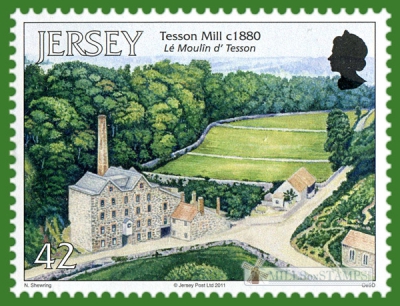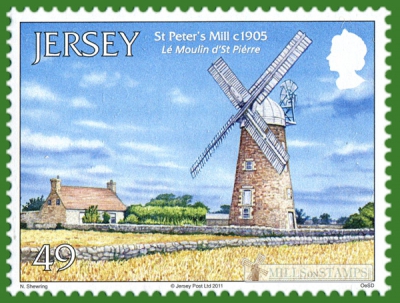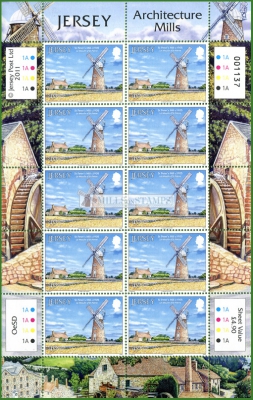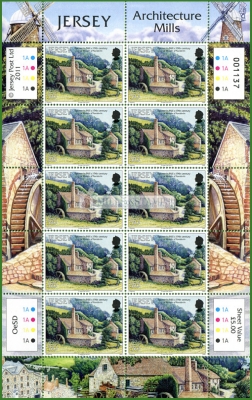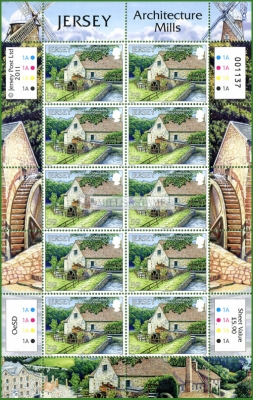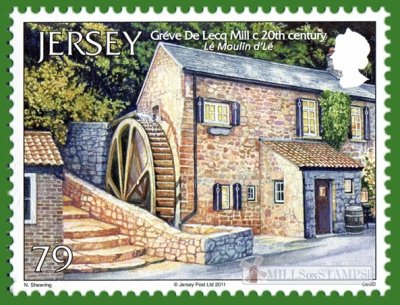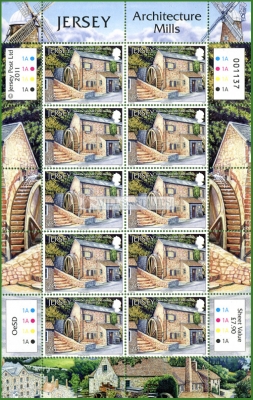-
Jersey Architecture: Mills
Jersey 2011.10.11
In issue: Stamp(s): 6
Issued in: sheets of 10 stamps
-
Perforation type: 14x14
Subject:
37 pence. Rozel Mill
Additional:
*Rozel Mill c.1880 - A tower mill is first mentioned on this site on Popinjay's map of 1563. Used as a sea-mark c.1919, the top was modified as a lookout by the Nazis during the Occupation of Jersey. Although an inscribed stone above the doorway suggests remodelling in 1799, the lower levels appear to be much older. The doorways are surmounted by a double row of small voussoirs, unlikely in the 18th or 19th centuries. Indeed, the lower sections of this windmill suggest that they date from the 14th or 15th century.
Topics: Windmills
-
Perforation type: 14x14
Subject:
42 pence. Tesson mill*
Additional:
*Tesson Mill c.1880 - First recorded in 1274, provision was added for a steam engine during the early 19th century. The mill was almost destroyed by fire in 1908 but was repaired and became extremely productive, grinding French wheat and a mixture of barley, oats and buckwheat. After the Occupation, it continued to operate but mainly with electric machinery. It was probably always overshot but the 17th century water wheel site was replaced in the 1830s rebuild with a double-width waterwheel.
More information You can find at official page of National Trust for Jersey
Topics: Watermills
-
Perforation type: 14x14
Subject:
49 pence. St. Peter's Mill*
Additional:
*St Peter's Mill c.1905 - In 1835 a group of landholders formed a company for the construction of a windmill bordering each of three Parishes, to grind wheat. The mill was sold in 1885; the sails were removed and an oil engine installed in 1911. It had two sets of French Burr mill stones of 4'4" diameter and an oat crusher. The mill was fitted with a set of four self-reefing whips at an angle of 15 degrees to the horizontal; it was winded by a fantail and was the last working windmill in Jersey.
Topics: Windmills
-
Perforation type: 14x14
Subject:
50 pence. Ponterrin mill*
Additional:
*Ponterrin Mill c. 19th century - The original mill may date to c.1066 and it was rebuilt in 1795. During the early 19th century, Ponterrin is described as being mills in the plural and this, in conjunction with the rounded building attached to its gable end, suggests that there was a secondary horse-mill. This may have been superseded by a steam engine as one is known to have been at the mill by c.1890. The mill had an overshot waterwheel driven by a leat system from a mill pond further up the valley.
Topics: Watermills
-
Perforation type: 14x14
Subject:
59 pence. Quetivel Mill*
Additional:
*Quetivel Mill c.20th century - First recorded in 1309, Quetivel Mill was tenanted by millers and was retained by the Crown until sold in the mid-16th century. The wheel was overshot with a leat running from the mill pond and it had fallen into disrepair by the early 20th century. After various efforts to make good the mill, it burnt down only to be restored by the National Trust for Jersey and it is now the only working mill in the Island.
More information You can find at official page of National Trust for Jersey
Topics: Watermills
-
Perforation type: 14x14
Subject:
79 pence. Greve de Lecq Mill*
Additional:
*Greve de Lecq Mill c.20th century - also known as Le Moulin de Lecq, this watermill is recorded from the late 13th century. It features the largest waterwheel in Jersey with a diameter of 21 feet and worked entirely by the weight of water for hundreds of years. It may have been a fulling mill in the later 18th century and was last used to grind corn before the Occupation 1940-1945. The Germans requisitioned the wheel to generate power for their searchlight batteries but this was unsuccessful.
__________
Please, also look at FDC for this issue
Topics: Watermills





